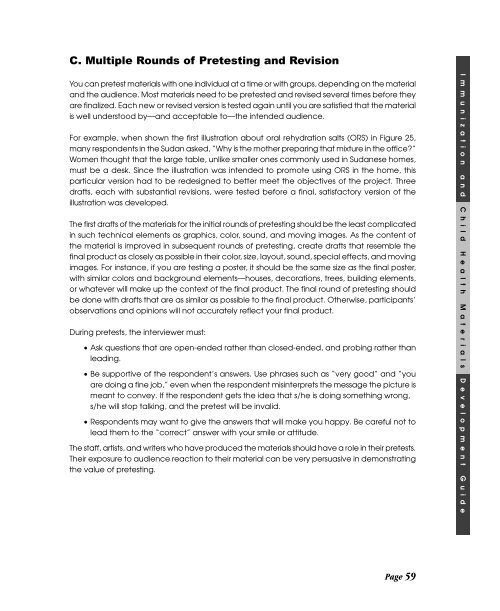Immunization and child health materials development guide pdf
Immunization and child health materials development guide pdf
Immunization and child health materials development guide pdf
Create successful ePaper yourself
Turn your PDF publications into a flip-book with our unique Google optimized e-Paper software.
C. Multiple Rounds of Pretesting <strong>and</strong> Revision<br />
You can pretest <strong>materials</strong> with one individual at a time or with groups, depending on the material<br />
<strong>and</strong> the audience. Most <strong>materials</strong> need to be pretested <strong>and</strong> revised several times before they<br />
are finalized. Each new or revised version is tested again until you are satisfied that the material<br />
is well understood by—<strong>and</strong> acceptable to—the intended audience.<br />
For example, when shown the first illustration about oral rehydration salts (ORS) in Figure 25,<br />
many respondents in the Sudan asked, “Why is the mother preparing that mixture in the office?”<br />
Women thought that the large table, unlike smaller ones commonly used in Sudanese homes,<br />
must be a desk. Since the illustration was intended to promote using ORS in the home, this<br />
particular version had to be redesigned to better meet the objectives of the project. Three<br />
drafts, each with substantial revisions, were tested before a final, satisfactory version of the<br />
illustration was developed.<br />
The first drafts of the <strong>materials</strong> for the initial rounds of pretesting should be the least complicated<br />
in such technical elements as graphics, color, sound, <strong>and</strong> moving images. As the content of<br />
the material is improved in subsequent rounds of pretesting, create drafts that resemble the<br />
final product as closely as possible in their color, size, layout, sound, special effects, <strong>and</strong> moving<br />
images. For instance, if you are testing a poster, it should be the same size as the final poster,<br />
with similar colors <strong>and</strong> background elements—houses, decorations, trees, building elements,<br />
or whatever will make up the context of the final product. The final round of pretesting should<br />
be done with drafts that are as similar as possible to the final product. Otherwise, participants’<br />
observations <strong>and</strong> opinions will not accurately reflect your final product.<br />
During pretests, the interviewer must:<br />
• Ask questions that are open-ended rather than closed-ended, <strong>and</strong> probing rather than<br />
leading.<br />
• Be supportive of the respondent’s answers. Use phrases such as “very good” <strong>and</strong> “you<br />
are doing a fine job,” even when the respondent misinterprets the message the picture is<br />
meant to convey. If the respondent gets the idea that s/he is doing something wrong,<br />
s/he will stop talking, <strong>and</strong> the pretest will be invalid.<br />
• Respondents may want to give the answers that will make you happy. Be careful not to<br />
lead them to the “correct” answer with your smile or attitude.<br />
The staff, artists, <strong>and</strong> writers who have produced the <strong>materials</strong> should have a role in their pretests.<br />
Their exposure to audience reaction to their material can be very persuasive in demonstrating<br />
the value of pretesting.<br />
Page 59

















